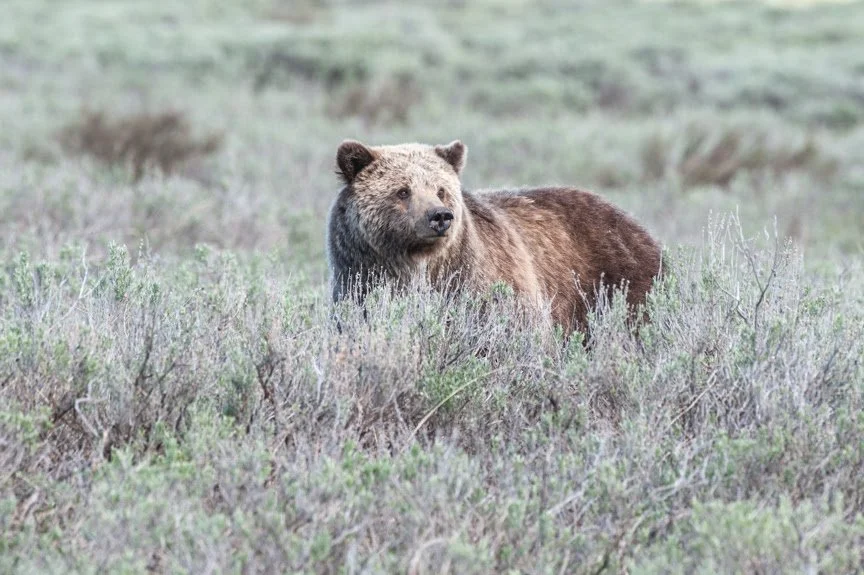Post-Town Hall Update: Living with Bears– How Prepared Are We?
Last week we gathered with Shields Valley residents at the Clyde Park Town Hall to talk about living in bear country. This is the season where everyone is hustling to get fields hayed or harvested before the cold hits, or just making the most of the last few weeks of daylight before the long winter nights arrive. Bears operate on the same timeline, which makes the chance for conflict with our community more likely.
We heard from Sadie Collins of Highland Harmony Farms. Sadie, who grew up in Wilsall, has seen a lot of changes over the years and understands the importance of respecting our wildlife, especially bears. After implementing bear mitigation techniques for about seven years, she shared a positive finding, the solution is simple— if they can't eat it, they move on! But consistency is key. Sadie still sees bears, but they no longer impact her operation like they used to.
Evan Stout and Blakely Adkins from Bear Awareness Gardiner highlighted a critical point, it’s human behavior that puts all bears at risk. They noted that apples are essentially the "gateway drug" for habituated bears. Cleaning up and removing fruit provides a simple, tangible way to keep bears out of trouble, and not just grizzlies. Even when black bears learn to relate humans to a food source, they can become very aggressive, a pattern seen across the country.
It is up to us to take measures to secure attractants and reduce the opportunities that create conflicts with black bears or grizzlies. It is our actions that make a difference. When we do nothing the consequences are often lethal for bears.
Read more for tips to keep our bears and communities safe, information on local apple donation programs, and a local grizzly bear update.
Grizzly bear in the sagebrush- photo by Tom Murphy.
We are already ahead of last year’s record pace for grizzly mortalities. According to a recent article from WyoFile, federal biologists have already listed 63 Yellowstone ecosystem grizzly bear deaths this year, surpassing last year's provisional count of 56 by the same date.
Adding to this urgency is the fact Montana has been under moderate to severe drought. The lack of natural food is pushing grizzlies out of their typical habitat and into the valleys to search for something to eat. This is especially concerning right now, as this movement coincides with the upcoming start of rifle season, a time of increased conflict risk for both people and bear mortality.
We're already seeing this play out locally. We've heard reports of heavy grizzly activity in Gardiner. The North Dry Creek Trailhead is closed due to attractants, and many of you saw the footage of the mama grizzly and two cubs near Emigrant.
The challenge of coexisting with bears requires us to be aware, intentional, and collaborative—exactly the skills we need to address the many interconnected issues we face as a community. Meetings and conversations like we had in Clyde Park are vital because they teach us how to find solutions together. By committing to responsible practices now, we become more proactive, and capable, making us a community truly ready to live with bears.
TIPS FOR LIVING WITH BEARS
Secure your home and property to prevent dangerous encounters:
Pick those apples—don't let fruit just set or fall to rot. Bears follow their noises and nothing smells sweeter than apples on a cool fall evening.
Check in with the Livingston Resource Food Center, they are accepting apple donations this year!
Drop off at Lockhorn Cidery in Bozeman until Oct 12th! Bring your extra backyard apples, crabapples, and pears to the Cider House! They’ll trade you a pint of cider for your fruit.
Remove bird feeders until winter—natural seeds are abundant this time of year. Fish Wildlife and Parks (FWP) generally recommends removing bird feeders from April through at least December 1st.
Secure your trash in a bear-proof container or enclosure with secure locks. Bears are smart and strong.
If you have honey bees, electric fences are necessary.
Let your neighbors know when you see a habituated bear and work together to figure out the best solution for your area.
For those running livestock, experts are reinforcing the effectiveness of strategies like range riding, carcass management, and electric fencing to reduce losses and habituated bears. If you need help– please let us know.
If you are outdoors:
Always carry bear spray when hiking or out in remote areas, and practice how to use it and how to access it quickly.
Be smart while hunting and properly secure carcasses.
Be aware while fishing; bears use riparian corridors for forage and travel.
Please let FWP, the Forest Service, and other necessary land managers know of any odd bear behavior seen while on public lands.
Watch this FWP video series on living in bear county to learn more.


